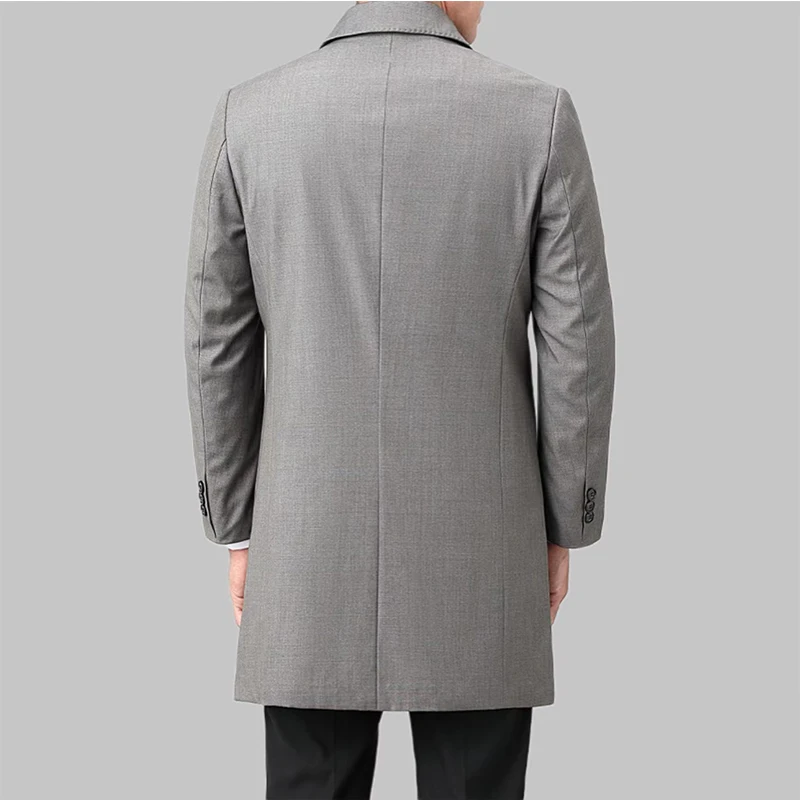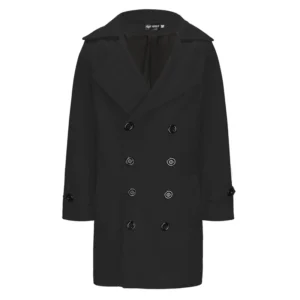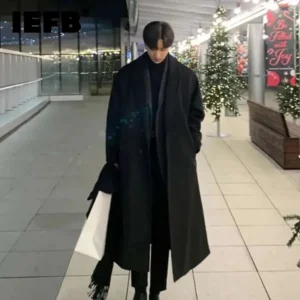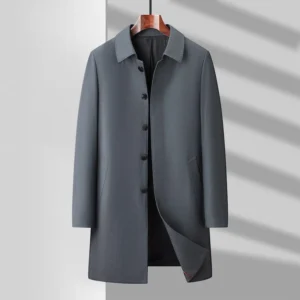Introduction: The Power of a Quality Business Coat
In the professional world, your appearance often speaks before you do. While suits, shirts, and shoes typically take center stage in business attire discussions, a quality dress coat serves as the crucial finishing touch that completes your professional image. It’s the first thing colleagues and clients see when you arrive and the last impression you leave when departing.
Unlike casual outerwear, business coats blend sophisticated style with practical function. They feature refined silhouettes, premium materials, and subtle detailing that harmonize with formal business attire rather than overshadowing it. The right business coat doesn’t just protect you from the elements—it enhances your professional presence and communicates attention to detail.
This comprehensive guide will walk you through everything you need to know about selecting, wearing, and maintaining business-appropriate outerwear. From classic overcoats to versatile trench coats, we’ll explore the various styles suitable for professional environments, dive into material and construction considerations, and provide practical advice on fit, styling, and coat care. Understanding the proper coat length selection for your professional appearance is just one of many essential factors we’ll examine in depth.
Why Your Business Coat Matters: Beyond Just Staying Warm
First impressions form quickly in business settings, often within seconds of meeting someone. Your outerwear plays a significant role in this initial assessment, particularly during colder months when your coat is visible during arrivals, departures, business lunches, and commutes. A well-chosen business coat signals attention to detail, professionalism, and good judgment—qualities highly valued in any business context.
Beyond impression management, business coats serve a crucial practical purpose. They provide necessary protection from cold, wind, and precipitation while maintaining a polished professional appearance. Unlike purely functional outerwear that might prioritize weather protection at the expense of style, business coats achieve both objectives without compromise.
Different business environments call for different levels of formality in outerwear. Traditional corporate settings with strict dress codes typically require more formal coat styles like classic overcoats or tailored topcoats. Meanwhile, business-casual workplaces might accommodate more relaxed options such as well-designed peacoats or car coats. Understanding your specific professional context helps narrow down the appropriate coat options.
From an investment perspective, quality business coats offer excellent value despite their initially higher price point. With proper care, premium coats can provide decades of service while maintaining their professional appearance. This long-term view makes selecting the right coat even more important—it’s not just a seasonal purchase but a professional wardrobe investment. The proper coat length for your height significantly impacts both comfort and professional appearance, making this consideration essential when selecting business outerwear.
Key factors when evaluating business coats include:
* Material quality and appropriateness for professional settings
* Construction durability that withstands daily professional wear
* Timeless style that remains appropriate across multiple seasons
* Versatility across different business contexts and dress codes
* Fit accommodations for business suits and formal attire underneath
Essential Business Coat Types: Matching Style to Professional Context
When selecting outerwear for professional settings, different coat styles serve distinct business needs and project varying levels of formality. The spectrum ranges from highly formal options like the classic overcoat to more versatile business-casual pieces like the peacoat. Your industry, personal style preferences, and local climate all influence which styles will work best for your specific situation.
Financial services, law, and traditional corporate environments typically demand more formal coat styles, while creative industries and tech companies often allow for greater flexibility. Similarly, your regional climate will determine whether you need heavier wool options for extreme cold or lighter-weight alternatives for milder winters. Let’s explore the primary business coat options and their professional applications.
The Classic Overcoat: The Executive Standard
The overcoat stands as the definitive business coat, characterized by its knee-length or longer silhouette, structured shoulders, and clean lines. With roots in military uniforms that evolved into civilian business wear, this style has become synonymous with executive presence and formal business environments.
Ideal for formal business settings, the overcoat pairs perfectly with suits and more formal business attire. Its longer length provides both practical warmth and a dignified silhouette that complements tailored clothing beneath. For the highest level of business formality, few options compete with a well-tailored overcoat.
Key features to look for in a business-appropriate overcoat include:
* Single or double-breasted front (single-breasted offering more versatility)
* Notch or peak lapels of moderate width
* Clean shoulder line with light padding
* Center vent or side vents for ease of movement
* Mid-thigh to knee length (42-48 inches or 106-122 cm)
* Simple, minimal pocket styling
The best overcoats for business are crafted from pure wool or wool-cashmere blends, typically in the Super 100s to Super 130s range for optimal drape and durability. Traditional business colors include navy, charcoal, camel, and black, with navy and charcoal offering maximum versatility across professional contexts. When investing in your professional wardrobe, wool overcoats provide exceptional versatility and longevity.
The Versatile Trench Coat: Classic All-Weather Option
Originally designed for military officers in the trenches of World War I, the trench coat has evolved into a sophisticated business essential that bridges the gap between weather protection and professional style. Its water-resistant design makes it particularly valuable for business professionals who must maintain a polished appearance despite unpredictable weather.
The business trench coat features distinctive elements including a double-breasted front, belted waist, epaulets, storm flaps, and a back vent. These functional details have become style signatures that distinguish this timeless piece. For business settings, trench coats should hit around knee length, offering sufficient coverage without overwhelming the frame.
Modern business trench coats are typically made from:
* Premium cotton gabardine with water-resistant treatment
* Cotton-polyester blends with enhanced weather resistance
* Lightweight wool gabardine for cooler climates
While the classic khaki remains a business standard, navy, black, and olive provide excellent alternatives that pair seamlessly with business attire. The trench coat’s versatility allows it to complement everything from formal suits to business casual attire, making it an excellent option for professionals who navigate varying levels of business formality. The history and refinement of classic men’s overcoats make them valuable additions to any professional wardrobe.
The Modern Peacoat: Business Casual Crossover
The peacoat offers a bridge between business functionality and relaxed sophistication, making it particularly suitable for business casual environments. Originally designed for naval personnel, today’s business-appropriate peacoats feature refined proportions and premium materials that elevate them beyond their utilitarian origins.
For business contexts, look for peacoats with:
* Cleaner lines and more tailored fit than casual variants
* Higher-quality wool with smoother finish
* Subtle, professional-looking buttons rather than bold anchor buttons
* Length hitting at the upper thigh rather than shorter casual styles
* Refined collar proportions that frame the face professionally
While peacoats work well in creative industries, tech companies, and other business casual settings, they generally aren’t appropriate for the most formal business environments or when wearing suits. They pair best with business casual attire including dress trousers, sweaters, and button-down shirts.
Industry context matters significantly when considering a peacoat for professional use. In traditional finance, law, or conservative corporate settings, the peacoat may be too casual for daily wear. However, in design firms, marketing agencies, or modern workplaces with relaxed dress codes, a well-designed wool pea coat can project appropriate professionalism while offering comfortable versatility.
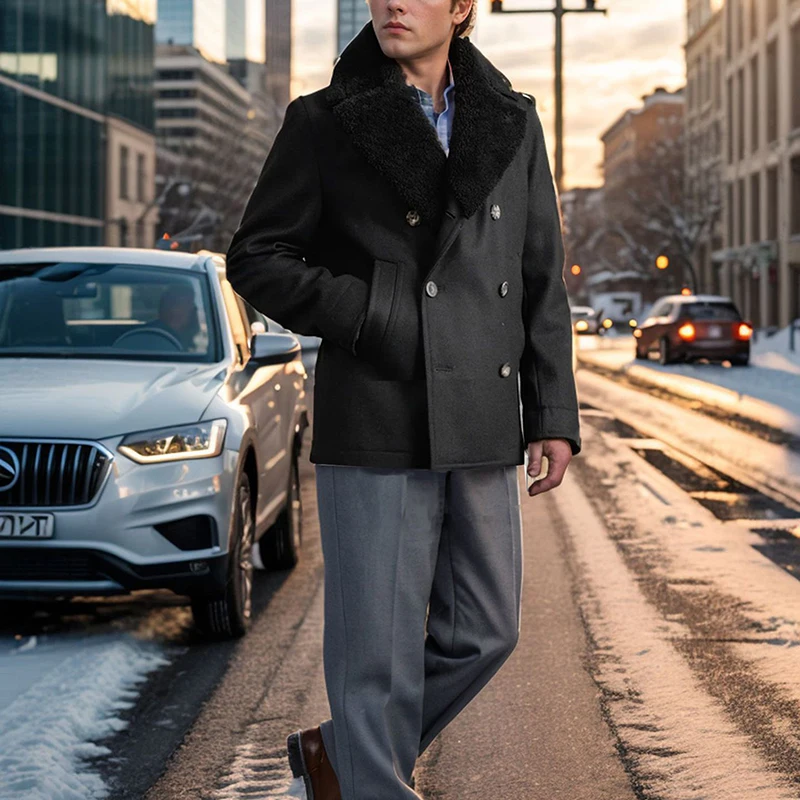
The Practical Car Coat: Commuter’s Companion
The car coat evolved specifically to accommodate the needs of driving professionals, featuring a shorter length (typically hitting mid-thigh) that allows for comfortable seated movement. This practical design makes it particularly well-suited for business commuters who spend significant time in vehicles while still requiring professional appearance upon arrival.
Business-appropriate car coats typically feature:
* Clean, minimalist design without excessive details
* Length hitting at mid-thigh (30-34 inches or 76-86 cm)
* Straight silhouette that layers comfortably over business attire
* Simplified closure system for easy on/off transitions
For professional environments, look for car coats in wool, wool blends, or refined technical fabrics with a matte finish. Suitable business colors include navy, gray, black, and camel, with darker shades offering greater versatility across professional contexts. The car coat pairs particularly well with business casual attire and can work with suits in less formal business settings.
The car coat serves as an excellent option for professionals who value practical functionality alongside appropriate business style. Its abbreviated length and mobility-oriented design make it especially valuable for active business professionals who move frequently between indoor and outdoor environments throughout their workday.
The Streamlined Mac Coat: Refined Rain Protection
The mac coat (or mackintosh) represents the quintessential lightweight business raincoat, featuring a clean, minimalist design that pairs seamlessly with professional attire. Its single-breasted front, concealed closure, and absence of excessive details create a streamlined silhouette that complements rather than competes with business clothing underneath.
Modern business mac coats have evolved considerably from their rubberized cotton origins. Today’s options typically feature:
* Technical fabrics with sophisticated waterproofing
* Breathable constructions that prevent overheating
* Clean, tailored silhouettes suitable for formal business contexts
* Minimal detailing focused on function rather than decoration
The mac coat’s understated design makes it appropriate across the business formality spectrum, from formal corporate environments to business casual settings. Its lightweight construction makes it particularly valuable for transitional seasons and business travel, where packability and versatility are paramount.
For maximum business versatility, choose mac coats in classic neutral colors like navy, black, or deep olive. These options pair easily with the full range of business attire while maintaining professional propriety across diverse business contexts.
The Distinguished Chesterfield: Ultimate Formal Business Coat
The Chesterfield represents the pinnacle of formal business coat styling, distinguished by its single-breasted front, velvet collar, and impeccable tailoring. This coat style embodies classic business formality, making it particularly appropriate for executives, formal business functions, and traditionally formal industries.
Key distinguishing features of the Chesterfield include:
* Contrasting velvet collar (typically in black)
* Clean front without belt or waist seam
* Often features a fly front with concealed buttons
* Structured shoulders with elegant drape
* Subtle details like ticket pockets or welted pockets
Ideal for the most formal business contexts, the Chesterfield pairs perfectly with suits, formal business attire, and evening business functions. Traditional business colors include charcoal, navy, and black, with the contrasting collar providing a subtle yet distinctive detail that signals refinement.
For the most formal business environments where exceptional polish is expected, the Chesterfield offers the perfect blend of traditional propriety and executive distinction. Its timeless design has remained relevant across decades of business fashion, making it a particularly sound investment for professionals in formal industries. Understanding how to select the perfect dress coat for formal occasions helps ensure your business outerwear meets the highest standards of professional propriety.
Essential Buying Guide: Selecting Your Professional Coat
Investing in business outerwear requires thoughtful consideration beyond basic style preferences. A systematic approach helps ensure your selection meets both professional standards and practical needs. Consider your purchase as a long-term business investment rather than a seasonal acquisition—quality business coats often provide years or even decades of service when properly selected and maintained.
The following sections will guide you through the key evaluation criteria for business coats, from material quality to construction details, fit considerations, and strategic investment approaches. These factors collectively determine not just how a coat looks on day one, but how it performs throughout years of professional service.
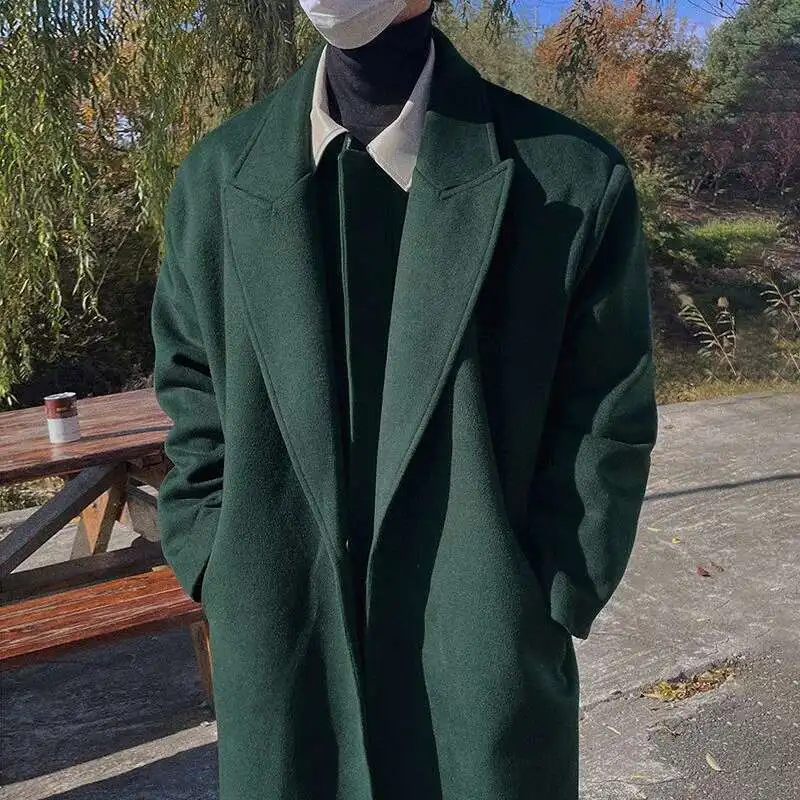
Professional Materials: Quality Indicators and Performance
Material selection significantly impacts a business coat’s professional appearance, performance, and longevity. For formal business environments, natural fibers typically offer superior drape, comfort, and refined appearance compared to synthetic alternatives.
Premium business coat materials include:
Pure Wool (100%): The gold standard for business coats, providing excellent warmth, natural wrinkle resistance, and professional appearance. Look for Super 100s-130s wool for optimal balance of refinement and durability.
Wool-Cashmere Blends: Often featuring 80-90% wool with 10-20% cashmere, these blends offer enhanced softness and luxury while maintaining practical durability for daily business wear.
Pure Cashmere: Exceptional softness and lightweight warmth, though typically less durable for everyday business use. Best reserved for special occasions or as a luxury second coat.
Gabardine: Tightly woven twill fabric with natural water resistance, ideal for business trench coats and rainwear. Available in both natural and synthetic versions.
Technical Wool: Modern blends incorporating performance fibers with wool for enhanced weather resistance while maintaining business-appropriate appearance.
For cold-climate business wear, look for fabric weights between 14-18 oz (400-510g) per yard, providing substantial warmth without excessive bulk. Moderate climate business coats perform well in the 10-14 oz (280-400g) range, offering versatile performance across seasonal transitions.
Quality business coats also feature thoughtful lining selections, typically using silk, viscose, or high-grade synthetic linings that facilitate smooth layering over business attire while enhancing comfort and longevity. Understanding how to select the perfect coat length for your height ensures your business outerwear achieves proper proportion and professional appearance.
Construction Quality: Evaluating Professional Craftsmanship
Superior construction distinguishes investment-quality business coats from temporary alternatives. Key construction elements to assess include:
Canvas Construction: Premium business coats feature floating canvas or half-canvas construction between the outer fabric and lining, providing structured shape without stiffness. This construction allows the coat to mold to the wearer over time for a personalized fit.
Seam Finishing: Examine how seams are finished—clean, consistent stitching with proper seam allowances indicates quality craftsmanship. In premium coats, interior seams are typically bound or taped for enhanced durability and refined appearance.
Pattern Matching: On patterned fabrics, quality coats show careful pattern alignment at seams, particularly visible at the center back seam and pocket placements.
Button Attachment: Quality business coats secure buttons with reinforced shanks and backing buttons on heavier materials, preventing button loss and fabric damage during regular professional use.
Lining Installation: The lining should hang smoothly without pulling or puckering, with adequate ease for movement over business attire.
When evaluating coats online, look for detailed construction descriptions and close-up images of these elements. For in-store assessment, check the weight and drape of the garment, examine interior construction, and test functional elements like closures and pockets.
Achieving Perfect Fit: Business Coat Proportions
Proper fit remains essential for business coats, particularly since they must accommodate professional attire underneath while maintaining a clean, proportional silhouette. Unlike casual outerwear, business coats should provide sufficient room for suit jackets without appearing oversized or sloppy.
Key fit considerations for business coats include:
Shoulders: The coat shoulder should extend slightly beyond your natural shoulder to accommodate jacket layering. Look for approximately 1/2 inch (1.25 cm) beyond where a suit jacket would end.
Chest and Torso: With a suit jacket underneath, you should be able to comfortably button the coat without visible pulling or excess fabric. The lapels should lie flat against the chest.
Sleeve Length: Coat sleeves should extend approximately 1/2 inch (1.25 cm) beyond suit jacket sleeves, which themselves should reveal about 1/4 inch (0.6 cm) of shirt cuff.
Overall Length: The appropriate length varies by coat style, but generally should provide proportional coverage without overwhelming your frame. Understanding the differences between short and long coat styles helps achieve proper professional proportion.
Collar Fit: The coat collar should sit cleanly against your neck without gapping when fully buttoned, allowing room for a scarf when needed.
Common business coat alterations include sleeve adjustment, waist suppression for a more tailored profile, and button repositioning for optimal closure. When purchasing investment-quality business coats, budget for potential alterations to achieve ideal fit.
Professional Color Selection: Building Your Business Palette
Color selection significantly impacts a business coat’s versatility and professional appropriateness. While personal preference plays a role, certain colors consistently perform better in business environments.
Core business coat colors in order of versatility:
Navy: The most versatile business coat color, pairing seamlessly with virtually all business attire from formal suits to business casual options. Navy projects authority while remaining approachable.
Charcoal Gray: Highly versatile and particularly compatible with gray suiting. Charcoal offers sophisticated neutrality appropriate across business contexts.
Camel/Tan: Provides a distinctive yet business-appropriate alternative to darker options. Most suitable for overcoats and topcoats in traditional styles.
Black: Though classic, black can sometimes appear severe in daylight business settings. Most appropriate for formal evening business functions or in creative industries.
Olive/Deep Green: A subtle alternative that remains sufficiently neutral for business settings while offering distinctive character. Best in less formal business environments.
Industry context influences optimal color selection, with traditional industries like finance and law favoring navy and charcoal, while creative fields accommodate broader color exploration. When building a business coat wardrobe, start with navy or charcoal before expanding to secondary options.
Regarding patterns, business coats generally favor solid colors or extremely subtle patterns like herringbone or small windowpane that read as solids from normal conversational distance. Bold patterns typically undermine the professional gravitas most business coats should project.
Investment Strategy: Budgeting for Professional Quality
Business coats represent significant investments, with quality directly correlating to price point in most cases. Understanding the value propositions at different price tiers helps make informed investment decisions:
Entry-Level ($150-300): Features wool-blend materials, basic construction, and acceptable appearance for limited professional wear. Typically lacks durability for daily business use beyond 1-3 seasons.
Mid-Range ($300-700): Offers pure wool construction, improved interior detailing, and better overall durability suitable for regular business wear. Represents the value sweet spot for many professionals.
Premium ($700-1,500): Features superior materials (higher-grade wool, wool-cashmere blends), half-canvas or full-canvas construction, and refined detailing. These coats offer significant longevity with proper care, often serving for a decade or more of professional use.
Luxury ($1,500+): Incorporates exceptional materials (cashmere, vicuña blends), hand-finished details, and bespoke-level construction. These represent lifetime investments for professionals in positions requiring the highest level of presentation.
When evaluating cost-per-wear, consider your wearing frequency, professional context, and care routine. A $700 coat worn 60 days annually for seven years costs approximately $1.67 per wearing—often less than a daily coffee and a sound professional investment.
For early-career professionals, focusing on a single versatile business coat (typically a navy or charcoal overcoat) often provides better value than multiple lower-quality options. As careers advance, expanding to specialty business coats becomes more justifiable.
Styling Your Business Coat: Professional Presentation
How you wear your business coat significantly impacts its professional effect. The fundamental principle is maintaining formality alignment—your coat should match or slightly exceed the formality of the attire worn beneath it. This ensures visual coherence in your professional presentation.
For formal business environments:
* Pair overcoats or Chesterfields with suits, dress shirts, and ties
* Ensure color harmony between coat and underlying attire (navy overcoat with navy or gray suit, for example)
* Maintain consistent formality in accessories (leather gloves, solid or subtly patterned scarves)
For business casual settings:
* Trench coats, car coats, or refined peacoats complement dress trousers, sweaters, and button-downs
* Greater color flexibility allows for thoughtful contrast (camel coat with navy trousers)
* Accessories can introduce subtle personality while maintaining professional propriety
Business travel presents unique outerwear considerations. Select coats with:
* Wrinkle-resistant materials that maintain professional appearance after packing
* Versatility across different business contexts you’ll encounter
* Weather appropriateness for your destination climate
The length and style of your coat significantly impact overall professional impression, making thoughtful selection essential for business success. Remember that proper coat styling extends beyond the garment itself—how you care for and maintain your business coat directly reflects your professional attention to detail.
Mens Double Breasted Pea Coat, Mens Wool Blend Coat, Mens Wool Pea Coat
Price range: $136.84 through $157.36 Select options This product has multiple variants. The options may be chosen on the product pageMens Black Overcoat, Mens Black Wool Coat, Mens Wool Overcoat
$339.18 Select options This product has multiple variants. The options may be chosen on the product pageMens Grey Overcoat, Mens Wool Blend Coat, Mens Wool Overcoat
$201.28 Select options This product has multiple variants. The options may be chosen on the product pageMens Herringbone Coat, Mens Long Overcoat, Mens Wool Overcoat
Price range: $197.16 through $203.69 Select options This product has multiple variants. The options may be chosen on the product page- Price range: $177.52 through $182.44 Select options This product has multiple variants. The options may be chosen on the product page
Mens Dress Coat, Mens Long Overcoat
$76.76 Select options This product has multiple variants. The options may be chosen on the product page
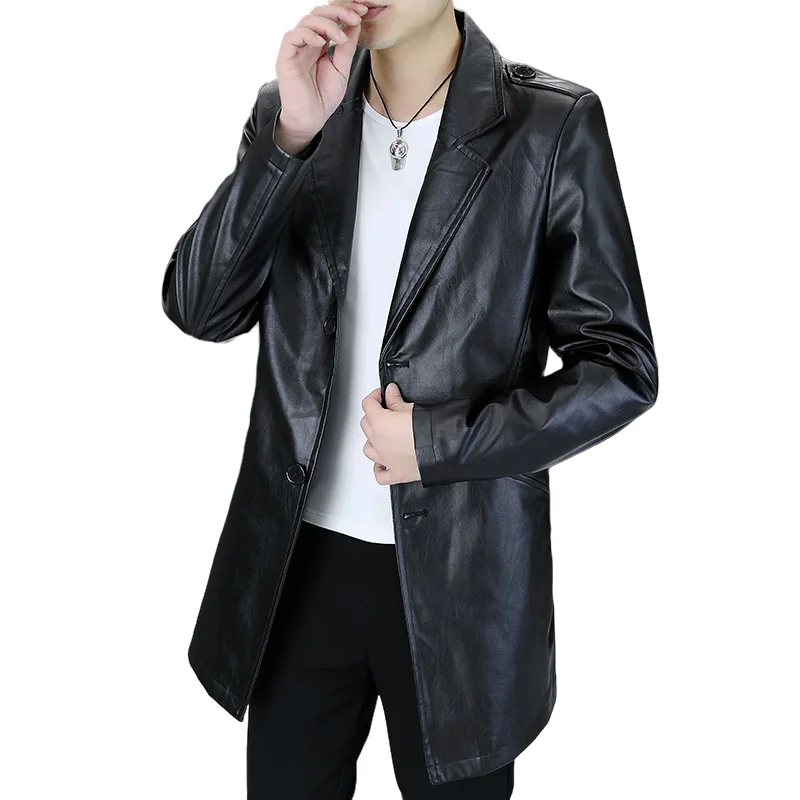
Care and Maintenance: Protecting Your Professional Investment
Proper maintenance ensures your business coat remains presentation-ready throughout its service life. Establish regular care routines that protect your professional investment:
Daily Maintenance:
* Brush your coat with a quality garment brush after each wearing to remove surface dust and debris
* Hang on proper wooden or padded hangers that support the shoulders without stretching
* Allow natural airing between wearings (at least 24 hours) to release moisture and prevent odors
* Address minor spots or spills immediately with a damp cloth before they set
Seasonal Storage:
* Thoroughly clean before extended storage
* Use breathable garment bags rather than plastic
* Add cedar blocks to deter moths without harsh chemicals
* Store in cool, dry locations away from direct sunlight
* Never compress business coats during off-season storage
Professional Cleaning:
* Follow material-specific cleaning recommendations (typically dry-clean only for wool and cashmere)
* Limit dry cleaning to 1-2 times per season as excessive cleaning can degrade natural fibers
* Use specialized wool detergents for washable wool blend coats
* Establish relationships with quality cleaners who understand proper business coat care
Preventive Maintenance:
* Apply fabric protector to non-wool business coats at the beginning of each season
* Reinforce buttons before they loosen or detach
* Address minor repairs immediately before they expand
* Consider professional reblocking every few years to restore original shape
With proper care, premium business coats often provide a decade or more of professional service while maintaining their distinguished appearance. This longevity significantly enhances their value proposition as professional investments.
Professional Coat FAQ: Expert Answers to Common Questions
How many business coats does a professional need?
Most professionals benefit from at least two complementary business coats—typically a formal option (overcoat) and a more casual or weather-specific alternative (trench coat or car coat). This provides appropriate options for varying business contexts and weather conditions. Senior executives or those in formal industries may require additional specialized options.
Can a peacoat be worn with a formal business suit?
While technically possible, peacoats generally don’t provide ideal proportion or formality for formal suiting. The shorter length and naval styling create a formality mismatch with business suits. For suit wear, overcoats, topcoats, or formal trench coats offer more appropriate business harmony.
What’s the ideal coat length for current professional standards?
Business coat length should generally follow these guidelines: formal overcoats and topcoats should fall between knee and mid-thigh; trench coats typically hit just above or at the knee; car coats and peacoats should end at upper to mid-thigh. Within these ranges, proportional balance with your height ensures optimal professional appearance.
How do I choose between similar business coat styles?
Evaluate your specific business context (industry formality, typical client interactions), climate needs, and existing wardrobe. Consider which coat type complements your most frequently worn business attire. For maximum versatility, single-breasted styles in navy or charcoal typically offer the greatest flexibility across business situations.
Are patterned coats appropriate in conservative business environments?
Subtle patterns like herringbone, small windowpane, or fine birdseye can be appropriate in conservative business settings when the pattern reads as textural interest rather than bold design from conversational distance. For maximum business versatility, however, solid colors remain the safest option in traditional professional environments.
Expert Recommendations: Evaluating Quality and Value
When investing in business outerwear, focus on these quality indicators across different price points:
Materials Assessment:
* Examine fabric composition tags for high natural fiber content (pure wool, wool-cashmere blends)
* Feel fabric weight and density—quality business coats have substantial hand-feel without stiffness
* Look for tight, consistent weave patterns without irregularities
* Check interior lining quality, including clean pattern matching at seams
Construction Evaluation:
* Examine stitching density (higher stitch counts indicate superior construction)
* Check seam allowances and finishing, particularly on interior components
* Assess button quality (natural materials like horn or corozo indicate premium construction)
* Look for balanced, symmetrical elements throughout the garment
Fit and Proportion:
* Evaluate shoulder construction for proper roll and natural drape
* Check collar and lapel for clean, flat positioning against body
* Confirm appropriate sleeve and body length for professional presentation
* Assess overall silhouette for clean lines without distortion
Value Proposition Considerations:
* Calculate potential cost-per-wear based on your specific professional context
* Consider versatility across different business scenarios and weather conditions
* Evaluate care requirements and maintenance costs over the garment’s lifecycle
* Balance immediate budget constraints with long-term investment perspective
Metro Cloak specializes in refined outerwear that meets these exacting professional standards. By focusing exclusively on quality men’s outerwear, their design team has developed specialized expertise in balancing the technical requirements of weather protection with the aesthetic demands of professional environments.
When selecting your business coat, remember that it serves as both practical necessity and professional statement. The right choice communicates attention to detail, good judgment, and respect for professional contexts—qualities that support success across all business endeavors.

